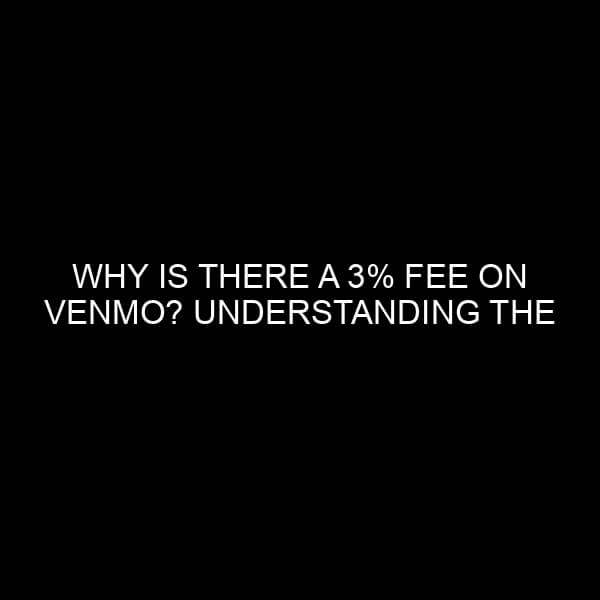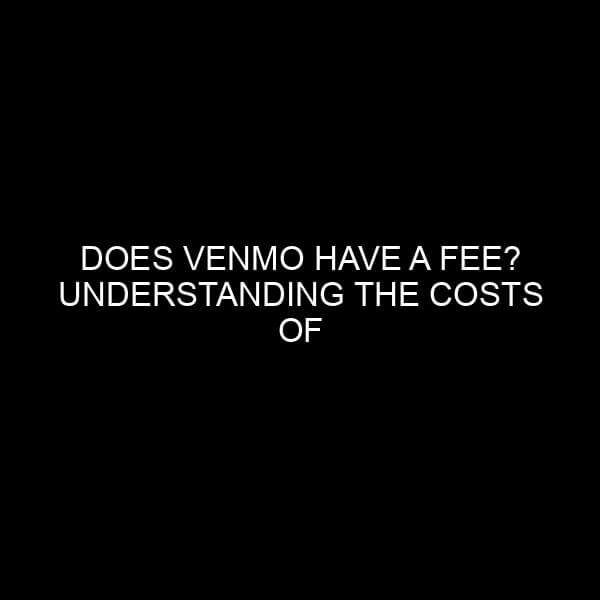Why is There a 3% Fee on Venmo? Understanding the Dynamics Behind Financial Platforms
In today’s digital era, online payment platforms such as Venmo have emerged as prominent tools for swift and seamless transactions. With just a few taps on our smartphones, we can send and receive money from friends, family, or anyone else on the platform. However, one feature that often raises eyebrows is the 3% fee that Venmo imposes on certain transactions. While this might seem arbitrary or cumbersome to some, there’s an underlying logic and business rationale behind it. This article aims to demystify this fee by delving deep into the dynamics of financial platforms and the broader banking industry.
Deciphering the 3% Fee: A Deep Dive
1. Operating Costs and Infrastructure
While digital transactions might seem instant and effortless, they are underpinned by a complex infrastructure that entails operational costs. This infrastructure includes:
- Servers and Data Centers: To ensure transactions are processed in real-time, Venmo must maintain a robust IT infrastructure, comprising servers and data centers, which require regular maintenance and upgrades.
- Security: Given the sensitivity of financial information, Venmo invests heavily in state-of-the-art security protocols, such as end-to-end encryption, to safeguard user data.
- Compliance and Regulation: Navigating the complex web of financial regulations necessitates legal expertise, periodic audits, and adherence to ever-evolving laws, all of which come at a cost.
2. Credit Card Processing Fees
A significant portion of the 3% fee can be attributed to credit card processing fees. When a user opts to fund their Venmo payment using a credit card, Venmo incurs fees from credit card companies. Instead of absorbing this cost, Venmo transfers it to the user. Debit card transactions or bank transfers, however, usually don’t carry this fee, encouraging users to opt for these modes of payment.
3. Profit Margins and Business Model
It’s crucial to remember that Venmo, like any other company, aims to achieve profitability. While many of Venmo’s features are free, the company strategically implements fees in specific areas to generate revenue. The 3% fee is one such revenue stream, ensuring the platform remains sustainable in the long run.
Comparison with Traditional Banking
Traditional banks have always charged fees, albeit in different forms. Overdraft fees, monthly maintenance charges, and ATM fees are just a few examples. In many ways, the 3% fee on Venmo mirrors the cost structures in conventional banking. However, the primary difference lies in transparency. While bank fees often catch customers off-guard, Venmo’s fee structure is straightforward and upfront.
Benefits of the 3% Fee
You might wonder if there’s any upside to this fee for users. In reality, there are several indirect benefits:
- Sustained Free Features: The revenue generated from this fee allows Venmo to offer many of its other services, like money transfers between friends or bank transfers, for free or at a reduced cost.
- Continued Innovation: A portion of this revenue is reinvested into research and development, ensuring that Venmo remains at the cutting edge of digital payment technology.
- Enhanced Security: As mentioned earlier, part of this fee goes into fortifying the platform’s security, offering users peace of mind when conducting transactions.
Alternatives and Best Practices
If you’re keen on avoiding the 3% fee, consider the following:
- Utilize Debit Cards or Bank Transfers: These funding sources usually do not carry the 3% fee, making them more cost-effective for users.
- Read the Fine Print: Familiarize yourself with Venmo’s fee structure to avoid any surprises.
- Compare Platforms: While Venmo is a popular choice, there are other digital payment platforms out there. Each has its own fee structure, so shop around to find the best fit for your needs.
Conclusion
While the 3% fee on Venmo might seem perplexing at first glance, it’s rooted in the intricacies of the financial and banking industry. By understanding the reasons behind this fee, users can make more informed decisions about their transactions, optimize their usage, and get the most value out of the platform. As digital payments continue to evolve, staying abreast of these dynamics ensures you remain ahead of the curve, reaping the benefits of convenience without any fiscal pitfalls.






